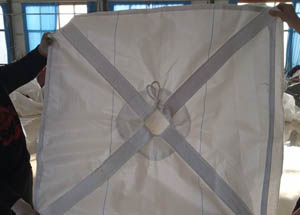
The production process of jumbo sak is: raw and auxiliary materials – > drawing – > weef – > coating – > cutting – > drukwerk – > sewing – > inner bag – > inspection – > finishing – > Verpakking – > warehousing.
In the above production process, drawing, weef, coating, cutting, drukwerk, inner bag, ens. are the main links of loss.
1.Wire drawing: this process is one of the processes with the highest consumption in the production of the plastic jumbo sak, and there are four links that generate losses:
1.1 there are plastic sheets and plastic blocks that do not form films when they are extruded into films by melting;
1.2 there are hard edges on both sides of the diaphragm when it is cut through cooling;
1.3 the fixed single wire is sucked into the waste wire chamber when it is wound to the bobbin.
1.4 the consumption of different specifications, varieties, colors, and filter screens shall be replaced each time.
2.Weaving: it also consumes a lot in this process. There are 3 processes in total to produce consumption:
2.1 the monofilament bobbin rotates on the warp frame and needs to be arranged in order. When the bobbin is put through the jumping rod and the thread is put through, there is the generation of hairiness, floating silk and dirty silk;
2.2 when the weft package enters into the shuttle of circular motion, there is the generation of wool, floating silk and dirty silk;
2.3 the consumption of single silk and single-piece process before and after extradition when the specifications and varieties of woven fabrics of different door frames and different units are replaced each time.
3.Coating: The coating process is the second process with high unit consumption. There are three small processes with high consumption:
3.1 the burr shall be cut off after the single woven fabric is coated;
3.2 when the raw material is extruded by melting, there is a high-temperature plastic melting material without film formation;
3.3 the consumption of single and composite woven fabric before and after each replacement of specifications and varieties with different door width and unit weight.
4.Cutting: the cutting process is the third process that produces high unit consumption, with 6 consumption points in total:
4.1 the shape of the material inlet and outlet is different, and the unit consumption is different. If the conical material outlet is connected with the bag body, the material waste is greater. Terselfdertyd, it is also affected by the length of the material outlet, and the longer the material outlet, the greater the unit consumption is;
4.2 for the consumption of the bag body, the bag cover on the bag body is connected with the feeding opening. The larger the size of the feeding opening is, the more waste the cloth of the bag cover to be dug is. Similarly, the size of the bottom cloth cover and the feeding opening is also one of the factors affecting the unit consumption;
4.3 partition bag: the purpose of the partition bag is to prevent the bulging around the bag after the bag body is loaded, which will affect the transportation, storage and save the site. There are many holes in each partition to facilitate the smooth flow of logistics. The size and number of holes dug are the places with the heaviest unit consumption;
4.4 the consumption of circular bag body is also large. Not only the holes should be dug at the bag cover and bag bottom at the inlet and outlet, but also the cover and bottom should be cut into a circle, so the unit consumption is larger;
4.5 the consumption of sling and strap is relatively small, generally due to the small consumption of wool and floating silk when wearing brown and buckle when changing varieties. 4.6 due to the professional automatic production equipment used, there will be inevitable time difference in case of broken wire or fault shutdown, which will affect the quality of woven cloth, strap, and other base materials. Daarom, the quality must be eliminated during cutting The base material of the second point also produces consumption.
5.Drukwerk: Plastic jumbo bag will consume positioning, proofreading and ink color when printing patterns or words.
6.Inner bag: the consumption of the inner bag is mainly caused by uneven blow molding control and excessive cutting.
7.Naaldwerk: the unit consumption of sewing thread used in the splicing of the plastic jumbo sak sewing process is very small, which can be ignored.

